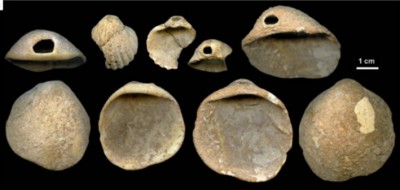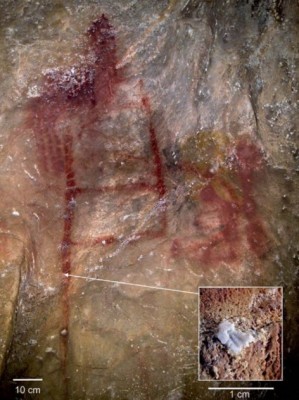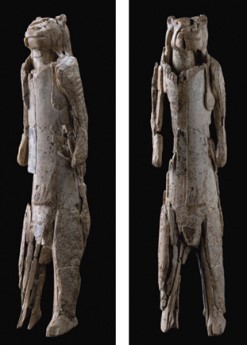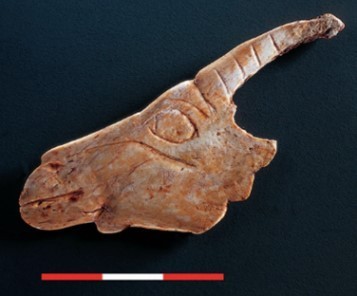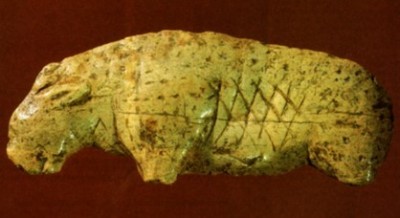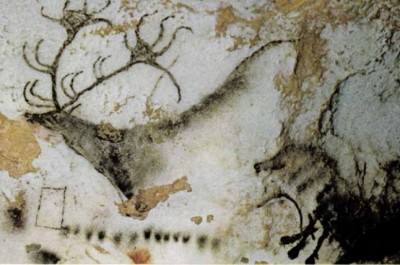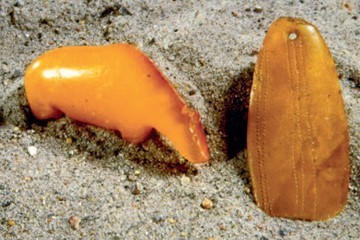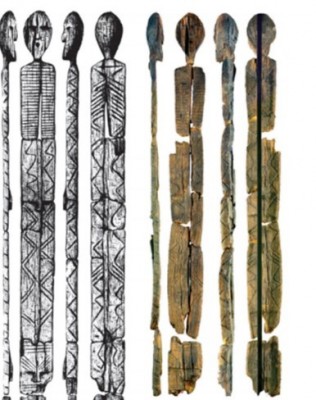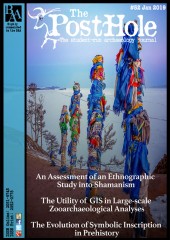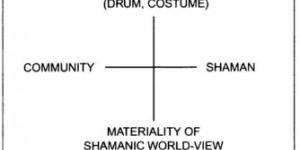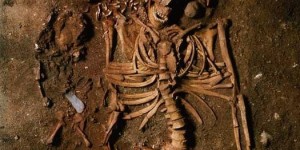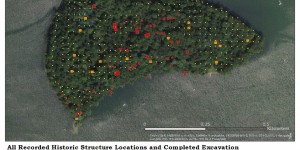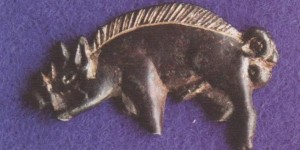Introduction
For the majority of human prehistory, inscription is the only manifestation of symbolic behaviour visible in the archaeological record. Symbolic behaviour is one of the few unchallenged markers of behavioural modernity (Texier et al. 2010). Its combination of symbols (symbolic inscription), language and abstract thinking are described as the “constitutive features of humanity” (Burduckiewicz 2014, 398). This essay will examine the emergence and development of different types of symbolic inscription, ranging from the Middle Palaeolithic to the Mesolithic. These include ornamentation, use of pigments, and abstract and figurative depictions (art), in both portable and parietal forms. Explanations for the motivations behind these features will also be investigated. Regarding the emergence of symbolic inscription in the Middle Palaeolithic, this essay will have a broad geographic focus. Contrastingly, the focus for the discussion of the later period will be restricted to Europe due to the quantity of data.
The Lower Palaeolithic
The Lower Palaeolithic appears to have witnessed the cognitive origins of symbolic behaviour (Burduckiewicz 2014). Evidence of this is provided in such few cases however, that despite issues of preservation, symbolic behaviour was likely not understood on a group level and played no part in social interactions between hominins. Regardless, the lack of comparable examples for these finds, and their vast temporal isolation from the next instances of symbolic behaviour in the record, mean that studies would be speculative. Examples include a geometric engraving on a shell dated to 450 kya, Acheulian petroglyphs from Auditorium Cave (India), and the possible Berekhat Ram Acheulian ‘figurine’ from Israel, a pebble believed to resemble an anthropomorphic form which was transported far from its origin (Bahn 1997).
The Middle Palaeolithic
It is in the Middle Palaeolithic where clear evidence is first found for the sustained production by cultures of symbolic inscription. Use of ochre and pigments, particularly red ochre or haematite, is one of the most enduring themes in prehistoric symbolism, likely due to the rarity of the colour in nature and its form as a natural paint. At the site of Maastricht-Belvedere in the Netherlands, red ochre, in a liquid solution spilled onto the ground surface, is dated to 200-250 kya. This peculiar use by Neanderthals is in the “same time range as early ochre use in the African record” by Homo sapiens populations. (Roebroeks et al. 2012, 1889). At Pinnacle Point in South Africa, pieces of red ochre dated to 164 kya show more conventional signs of use, displaying marks suggesting the pieces were ground and scraped (Marean et al. 2007). The use of ochre for symbolic purposes in early cases such as these is not definite. Ethnographically, red ochre is known to be used for a number of more utilitarian purposes, such as medication and insect repellent (Roebroeks et al. 2012). It was also used in the African Middle Stone age as an ingredient in adhesive used for hafting tools (Wadley et al. 2009). Ochre seen later in the record, however, is found in overwhelmingly symbolic contexts. It is present in one of the earliest Homo sapiens burial sites, Qafzeh in Israel (~100,000 kya), both in one grave and in a “defined area of ochre processing” in a cave (Pettitt 2011, 68). Some of the earliest instances of abstract art, discussed below, also involve ochre. The record therefore indicates that the use of ochre at early sites like Pinnacle Point was likely symbolic in nature, perhaps involving the daubing of ochre on the body or the depiction of abstract signs on hides.
Another key form of symbolic inscription emerging in the Middle Palaeolithic is the use of ornamentation. The earliest documented ornaments are mollusc shells, possibly associated with some of the earliest Homo sapiens burials at Skhul in Israel, dated to around 120kya. These are naturally perforated and “likely… represent modern human behaviour” (Bar-Yosef Mayer et al. 2009, 313). A more definite case of early ornamentation is seen at Qafzeh Cave, Israel, where naturally perforated shells, collected at least 35 km from the site, bear wear patterns consistent with being strung. Some are also stained with ochre. They are dated to 92 kya. (Bar-Yosef Mayer et al. 2009). Like the use of pigments, the use of ornamentation in the Middle Palaeolithic also emerges across Europe and Africa in a relatively similar time frame. A comparable early European example of ornamentation comes from Cueva de los Aviones in Spain, where similar shells, perforated and bearing traces of ochre, were found in a layer dated to 115 kya (Hoffmann et al. 2018a; see Figure 1).
A shell containing a mixture of different pigments was also found, possibly a paint cup, along with a bone point bearing pigment traces on its tip, possibly used to pierce painted hides or apply pigment itself (Zilhão et al. 2010). More diverse types of ornamentation are also observed later in the Middle Palaeolithic. Cut marks on bird bones at Fumane Cave in Italy, dated to 44 kya, indicate “the intentional removal of large feathers by Neanderthals” (Peresani et al. 2011, 3888). Complementing this, cut marks on eagle bones dated to ~50 kya at Rio Secco Cave in Italy and Mandrin Cave in France, indicate that eagle claws were deliberately detached from the feet. An “attractive hypothesis” here is the suspension and ornamental display of the claws, something seen in the ethnographic record (Romandini et al. 2014, 2). In addition to practices of ornamentation and pigment use, the earliest evidence for a tradition of abstract geometrical design comes from Blombos Cave in South Africa. Complex geometric engravings have been found on pieces of ochre in levels ranging from 100 to 75 kya (see Figure 2).
Designs include cross-hatching, dendritic forms and right-angled juxtapositions (Henshilwood et al. 2009). Henshilwood et al. (2009, 45) mention five other sites from the African Middle Stone Age that have produced artefacts with similar engravings and conclude that “the Blombos Cave engravings are not isolated cases”. The 270 fragments of engraved ostrich eggshell from Howiesons Poort dated to ~ 60 kya represent a similar tradition lasting several thousand years (Texier et al. 2010). Comparable abstract designs are also known from the same period in the parietal art of Neanderthal Iberia, with a ladder like linear motif from La Pasiega and a hand stencil from Maltravieso, both dated to at least 64 kya (Hoffmann et al. 2018b; see Figure 3).
Symbolic inscription was likely much more widespread on organic materials; Henshilwood et al. (2009) suggest that the Blombos engravings could have been templates for designs produced on a wider range of materials using the ochre power. However, systems of symbolic inscription in the Middle Palaeolithic do not display the level of unity associated with more structured symbolic systems (Henshilwood et al. 2009), such as early forms of writing. Although we will never be able to precisely decipher their meanings, we can consider their purpose. Cognitive development can be seen clearly throughout the Palaeolithic in the archaeological record, in the increasingly advanced technical skills of early hominins and their expanding understanding of, and ability to master, their environment. The appearance of symbolism is direct evidence of further cognitive developments that allowed information, likely relating to social interactions, to be stored in objects external to the human brain (d’Errico et al. 2003). Both individual status and group sentiment could be indicated via symbolism. Symbolism, while surely facilitated by language, allowed the expression and exploration of concepts previously restricted by lack of a more complex language, and likely developed alongside it.
The Upper Palaeolithic
The movement of Homo sapiens eastwards through Europe and the appearance of their Aurignacian culture defines the beginnings of the subsequent Upper Palaeolithic period. This began in Eastern Europe around 45 kya, and by 27 kya the last of the Neanderthals had perished in Iberia, their final refugia (Lewis-Williams 2002). Symbolic inscription in this period is defined by the appearance of figurative art among Homo sapiens populations, in both portable and parietal forms. Abstract symbolism continued to flourish alongside it.
The use of ornamentation continued to diversify throughout the Upper Palaeolithic. From the beginning of the Aurignacian, stone, ivory and teeth, both animal and human, were perforated and shaped to form a wide range of ornaments (White 1989).
The first form of figurative art to emerge was the three-dimensional sculpture. The earliest examples of this tradition are the Aurignacian ivory figurines of the Swabian Jura in southwestern Germany, the oldest being the therianthropic ‘lion-man’ figurine of Stadel Cave, dated to ~40 kya (Kind et al. 2014; see Figure 4).
Other examples include the ‘Venus’ of Hohle Fels, a microcephalic female figurine with exaggerated sexual characteristics, dated to ~35 kya (Nowell & Chang 2014), and depictions of a horse’s head and a diving waterfowl, both older than 30 kya (Conard 2003). Female or ‘Venus’ figurines, like the example from Hohle Fels, are one of the most enduring themes in Upper Palaeolithic sculpture. Concentrated in the Gravettian period (~27 - 20 kya) and distributed across Europe, their design varies, with regional differences in the choice of body parts accentuated and the design of clothing depicted (Soffer et al. 2000).
The most prolific form of sculpture in the Upper Palaeolithic consists of naturalistic animal carvings on bone, antler and ivory (see Figure 5). Functional examples include decorated tools such as spear throwers, but the majority are non-utilitarian. Production of these pieces was at its height during the Magdalenian period around 20 – 13.7 kya (Sieveking 1991). Engraved stone plaquettes also featuring animal depictions, predominantly horse and deer, complement these designs and are found throughout the Upper Palaeolithic (Sieveking 1991). Distribution of these pieces is largely centred in Western Europe (Laming-Emperaire 1959).
The use of abstract design continued to flourish in the Upper Palaeolithic in conjunction with the use of figurative images, and the two were often combined. Many of the Aurignacian ivory animal statuettes from Germany are engraved with abstract designs, such as chevrons and crosses (White 1989; see Figure 6). Abstract designs are also noted on numerous other portable artefacts throughout the Upper Palaeolithic, including Aurignacian bone plaques, Solutrean stone slates and Magdalenian bone/antler pieces (Marshack 1972; Sieveking 1991). Abstract design is also merged with figurative depiction in the Magdalenian, through the production of highly stylized schematic images of women, found across central and Western Europe (Fiedorczuk et al. 2007).
In addition to its use in portable artworks, the figurative representation of animals also developed in the parietal art of the Upper Palaeolithic. Largely confined to the caves of southern France and northern Spain (Laming-Emperaire 1959), these enigmatic images, both painted and engraved, are some of the most outstanding in the prehistoric record. The animals depicted “rarely correspond to the preys killed and eaten on habitation sites” (Clottes 2013, 11). The species focus varies but mainly involves horse and bovids in the main galleries, with more dangerous species such as lions depicted less frequently and further into the caves. Therianthropic figures appear rarely and are depicted in very simple fashion. No elements of landscape are depicted, and panels are often palimpsests of images with little concern shown for overlap (Laming-Emperaire 1959). The irregular cave walls, “far from hampering the artists, would seem to have guided and inspired them” (Laming-Emperaire 1959, 28), with many animals seeming to emerge from, or be constrained by, natural features of the rock. A number of abstract symbols also frequently appear alongside the figurative depictions, including latticed signs, dendritic forms, punctuations, tectiforms and claviforms (see Figure 7). Some are thought to represent weapons and traps, but the majority are more ambiguous (Laming-Emperaire 1959; Sieveking & Sieveking 1962).
During the Upper Palaeolithic, “population densities may have equalled those of the first agricultural communities” (Lewis-Williams 2002). In light of these increasing populations, and the sharing of the landscape with Neanderthal communities in the early Upper Palaeolithic, figurative depictions likely emerged in symbolic inscription due to increasingly complex social relations necessitating symbols which held more information. People were living in greater densities and likely interacting more than at any previous point in history, developing complicated social identities and displaying these in their art. The social nature of Upper Palaeolithic art becomes apparent when examining its temporal distribution. For example, parietal emblematic art, concerned with group identity, was favoured during the conditions of refugia after the last glacial maximum, when social tensions were at their highest. Portable art, instead of an assertive style, emphasised individual identity and is more widely distributed temporally (Barton et al. 1994).
Figurative symbolism likely developed alongside fully modern language or was enabled by its development. In Mithen’s ‘Prehistory of the Mind’, modern language is the ‘vandal’ that breaks the walls between the separate, specific intelligences of the human mind, allowing new levels of abstract thought and enabling the figurative depictions of the Upper Palaeolithic (Mithen 1996).
In the Middle Palaeolithic it was only possible to consider the purpose of symbolic inscription. In contrast, the structured nature of Upper Palaeolithic parietal art, with regards to compositional style and features, allows us to look past its purpose as the transmission and recording of social information and consider its meaning. Early ideas included the notion of sympathetic hunting magic, but as “only 15% of Upper Palaeolithic bison images seem to be wounded or dying” (Lewis-Williams 2002, 47), this interpretation seems flawed. Other scholars, such as Leroi-Gourhan (1982), utilised complex structural examination of the art in order to explore meaning. Leroi-Gourhan (1968b, 174) described the structure of binary oppositions he found in the art as “the expression of ideas concerning the natural and supernatural organisation of the living world”. Arguably the most convincing interpretation is that of Clottes (2013) and Lewis Williams (2002), who suggest the entoptic phenomenon of shamanistic trance states as the motivation for these depictions.
The key principles of ethnographically observable shamanism, taken from Zvelebil (2008, 43-44), involve belief in “a three tier universe of the upper world (sky), the middle world (earth) and the underworld (underground)”. The underworld also corresponds with water. These three vertical tiers are also seen to exist on a horizontal level. Belief in spirits is central, and “relationships of exchange and reciprocity… occur through communication with supernatural spirits” (Zvelebil 2008, 44). Shamans, through the entrance into altered states of consciousness, move between worlds and communicate with the spirits (Zvelebil 2008).
This shamanistic interpretation explains the subterranean nature of the art, with caves being liminal spaces between worlds, and the taking of inspiration from the natural surface as the result of entranced shamans perceiving the spirits in the shapes of the cave walls. Therianthropic figures represent the shamans themselves communing with the spirit world: practices of fluting (Van Gelder & Sharpe 2009) and the insertion of items into cracks in the cave wall represent attempts to interact with the ‘veil’ over the spirit world (Clottes 2013). Further evidence supporting this shamanistic interpretation is the continuity between the artistic traditions of the Magdalenian and Maglemosian cultures (Clarke 1936; Veil et al. 2012), in light of the acknowledged shamanism in Mesolithic northern Europe (Zvelebil 2008).
The ‘trance states’ of shamans, used as a tool to move between the three worlds of their belief system and commune with the supernatural world (Zvelebil 2008) are seemingly not fanciful imaginations, but very real altered states of consciousness. Investigations into the acoustics of the early Neolithic long barrow tomb of West Kennet (Marshall 2016), have revealed that resonance produced inside the central passage of the tomb by various sounds, such as drum beats or vocal chanting, can be of such low frequencies that the brainwaves of people inside the tomb can be altered as they entrain , or oscillate in time with, these frequencies. This alteration of the speed of brain waves can naturally produce altered states of consciousness. Marshall (2016) has reported visual anomalies such as the apparent movement of stones of the barrow, and the appearance of ‘passages’ opening within these stones as a result of frequencies generated by the chambers in the tomb. The natural resonance of caves used in the Upper Palaeolithic could therefore be used to enable altered states of consciousness, with the art possibly acting to stimulate visual anomalies, or alternatively produced as a record of perceived trance visions resultant from these altered states of consciousness. Acoustic investigation of the properties of Upper Palaeolithic cave sites is therefore of paramount importance. Altered states of consciousness are also not solely produced by acoustic phenomena; the use of many species of psychedelic plants to reach altered states of consciousness are well documented ethnographically, a classic example being the use of Ayahuasca in the Amazon (Talin & Sanabria 2017). Knowledge of a wide variety of plants and their various properties is ancient, dating back to “at least 77 kya in South Africa” (Villa et al. 2012). Liminal spaces such as caves may have been focus of ritual activity of this kind, with the lack of light aiding the perception of entoptic phenomenon produced by altered states of consciousness.
Visions produced by these altered states of consciousness include “iridescent geometric percepts” followed by full, culturally specific hallucinations (Lewis-Williams 2014, 637). That visions of this nature were the inspiration for many Upper Palaeolithic, and later Mesolithic images, is definitely a worthy hypothesis.
The Mesolithic
The following Mesolithic period, its beginning defined by the end of the Younger Dryas (Milner & Mithen 2009), saw the disappearance of the famed parietal art of the Upper Palaeolithic. The retreat of the glaciers resulted in population dispersal, distributing the complex social body of Upper Palaeolithic in Western Europe. This, combined with the extinctions of the megafauna which were popular subjects of the art, resulted in the style fading.
Abstract designs are the most prominent in this period, seen on many Scandinavian amber pendants (Toft & Brinch Petersen 2013) and on numerous pieces of antler and bone, often tools (Clark 1936). Small stones, such as the Azilian and Rhuddlan pebbles (Pluciennik 2008, Milner et al. 2016) also feature abstract designs. Clarke (1936) recognized 24 types of geometric motifs and three techniques of engraving, distributed on items across northern Europe from the early Mesolithic Maglemosian culture.
Figurative depiction persist largely in small ornaments and sculptures in the classic mediums. However, the use of amber does emerge. Examples of figurative depictions include amber animal figurines from Scandinavia (Vang Petersen 2013; see Figure 8), an anthropomorphic figurine likely representing a wrapped corpse from Estonia (Jonucks 2016), and the Oleni Island figurines from Russia, which include therianthropic depictions and an unusual anthropomorphic figurine with two faces (Popova 2001).
Parietal art does not disappear entirely in the Mesolithic. Many open air rock art sites are known from northern Europe and Siberia and combine anthropomorphic figures, animals and abstract designs, along with depictions of boats, tools and weapons (Zvelebil 2008). Two lines of engraved crosses at Aveline’s Hole, Somerset, represent one of the only instances of Mesolithic parietal art in Britain (Milner et al. 2016). Interestingly, similar “indeterminate vertical linear markings” (Pluciennik 2008, 356) are also seen on Italian and Sicilian cave walls. Naturalistic depictions of humans and animals are also seen around Sicily (Pluciennik 2008).
Unlike the previous Palaeolithic periods, the more recent Mesolithic record includes examples of organic artefacts that have survived in exceptional conditions. These represent rare examples of symbolic inscription in the medium that it was probably most common. The Shigir idol from Russia is a massively tall and thin wooden sculpture, probably originally over 4 metres high and around 25cm wide, covered in geometric designs and faces, and ending with a three-dimensional carving of a head (Chairkina 2014; see Figure 9). Imposing sculptures like the Shigir idol may once have dotted the Mesolithic landscape, present for example in the large Mesolithic post holes excavated near Stonehenge (Jacques et al. 2014). Other organic symbolic artefacts include 21 red deer antler frontlets from Star Carr, pierced for use as masks (Milner & Mithen 2009). These were likely used by shamans, who often “take the shape of… the elk or deer” (Zvelebil 2008) to represent their connection with animal spirits.
Shamanism & Symbolism
The shamanistic world view seems the most likely motive behind the majority of symbolic inscription in the Mesolithic. Belief in the shamanistic three-tier world of water, earth and sky can be seen in many aspects of the Mesolithic record, including the location of ritual sites on coastal zones where land and water met, and the burial of the dead on islands ‘beyond the water’ (Larsson 2004, Zvelebil 2008, 45). Water birds, a common theme in burials and figurative representation, and snakes, seen represented in the Oleni Island figures, were depicted due to the belief that these animals had the ability to pass between the tiers of the world (Zvelebil 2008). The bones of seals, which also pass between tiers, are seen deposited in close proximity to human remains at the Cnoc Coig midden on Oronsay (Meiklejohn et al. 2005).
The deposition of animal images is observed ethnographically among shamanistic peoples in order to appease spirits (Zvelebil 2008); the deposition of amber animal figurines in wetland areas in the Mesolithic (Vang Petersen 2013) could have performed a similar role, wetlands being liminal areas, like caves, where the world tiers cross and spirits may be found.
Direct evidence of shamanism can also be found in the Mesolithic. At Bad Durrenberg, Germany, an adult woman was found with a highly unusual assemblage of grave goods, including 65 fragments of tortoise shell (Porr & Alt 2006), also present in a Natufian shaman burial (Grosman et al. 2008). The unusual assemblage was what first led to the skeleton being classified as a shaman. Subsequently however, neurological disorders were identified on the Bad Durrenberg skeleton “which might have caused variants of altered states of consciousness” (Porr & Alt 2006, 395), the key component of shamanism. Possible shaman burials, clearly differentiated from others in terms of posture and grave inclusions, are also recorded at a number of other sites including Olenii Ostrov and Skateholm (Zvelebil 2008). “Anthropomorphic figures with drums and other musical instruments” (Zvelebil 2008, 49) are noted in a number of petroglyphs and are thought to represent shamans.
Further evidence to support this shamanistic interpretation of the symbolic record of the Mesolithic is the evidence of ethnographically documented shamanistic beliefs. “Northern hunter-gatherer and reindeer herding communities in northeast Europe and western Siberia can serve as an analogy for the earlier belief systems of prehistoric communities in circum-Baltic Europe” (Zvelebil 2008, 42). Zvelebil (2008, 42-43) argues that ethnographic analogy with these modern shamanistic societies “is valid” due to the prehistoric and ethnohistorical communities sharing “broadly similar temporal, practical and cosmological structures”.
The Emergence of Symbolism
In conclusion, progression and development of symbolic inscription can clearly be observed between the Middle Palaeolithic and the Mesolithic. The Lower Palaeolithic likely holds the cognitive origins of the human capability for symbolism as it gives us our earliest examples of the practice. It is the Middle Palaeolithic, however, where symbolic inscription appears to become a key social factor. In this period we see the earliest evidence for societal traditions of abstract symbolic inscription. Likely before the advent of fully modern language, symbolism at this stage allowed societies to explore and express new social concepts and possibly to consider their place in the world. The Upper Palaeolithic saw the emergence of figurative art loaded with symbolism, reflecting the increasing social integration of European communities. Exploration of altered states of consciousness likely began as the fully modern mind emerged along with modern language. The Mesolithic, a period defined by environmental changes, saw a continuing exploration of shamanism as people sought balance in a changing world. Themes alter however, reflecting the changing fauna and landscape of the Holocene world and the evolution of nomadic societies. The underlying inspiration behind the art seems to remain however as the shamanistic world-view.
Bibliography
Arias, P. (2009). ‘Rites in the dark? An evaluation of the current evidence for ritual areas at Magdalenian cave sites,’ World Archaeology 41(2), 262-294.
Bahn, P G & Vertut, J. (1997). Journey through the Ice Age. London: Seven Dials.
Bar-Yosef Mayer, D., Vandermeersch, B. & Bar-Yosef, O. (2009). ‘Shells and ochre in Middle Palaeolithic Qafzeh Cave, Israel: indications for modern behaviour,’ Journal of Human Evolution 56, 307-314.
Burduckiewicz, J-M. (2014). ‘The origin of symbolic behaviour in Middle Palaeolithic humans: Recent controversies,’ Quaternary International, 326-327, 398-405.
Chairkina, N M. (2014). ‘Anthropomorphic wooden figurines from the trans-urals,’ Archaeology, Ethnology and Anthropology of Eurasia 42/1, 82-89.
Clarke, G. (1936). The Mesolithic settlement of northern Europe. Cambridge: Cambridge University Press.
Clottes, J. (2013). ‘Why Did They Draw in Those Caves?,’ Time and Mind 6(1), 7-14.
Conard, N J. (2003). ‘Palaeolithic ivory sculptures from southwestern Germany and the origins of figurative art,’ Nature 436, 830-832.
d'Errico, F., Henshilwood, C., Lawson, G., Vanhaeren, M., Tillier, A-M., Soressi, M., Bresson, F., Maureille, B., Nowell, A., Lakarra, J., Backwell, L., & Julien, M. (2003). ‘Archaeological Evidence for the Emergence of Language, Symbolism, and Music - An Alternative Multidisciplinary Perspective,’ Journal of World Prehistory 17(1), 1-70.
Diaz-Andreu, M. (1998). ‘Iberian post-palaeolithic art and gender: discussing human representations in Levantine art,’ Journal of Iberian Archaeology 0, 33-51.
Fiedorczuk, J., Bratlund, B., Kolstrup, E., & Schild, R. (2007). ‘Late Magdalenian feminine flint plaquettes from Poland,’ Antiquity 81, 97-105.
Grosman, L., Munroe, N D., & Belfer-Cohen, A. (2008). ‘A 12,000-year-old shaman burial from the southern Levant (Israel),’ PNAS 105(46), 17665-17669.


